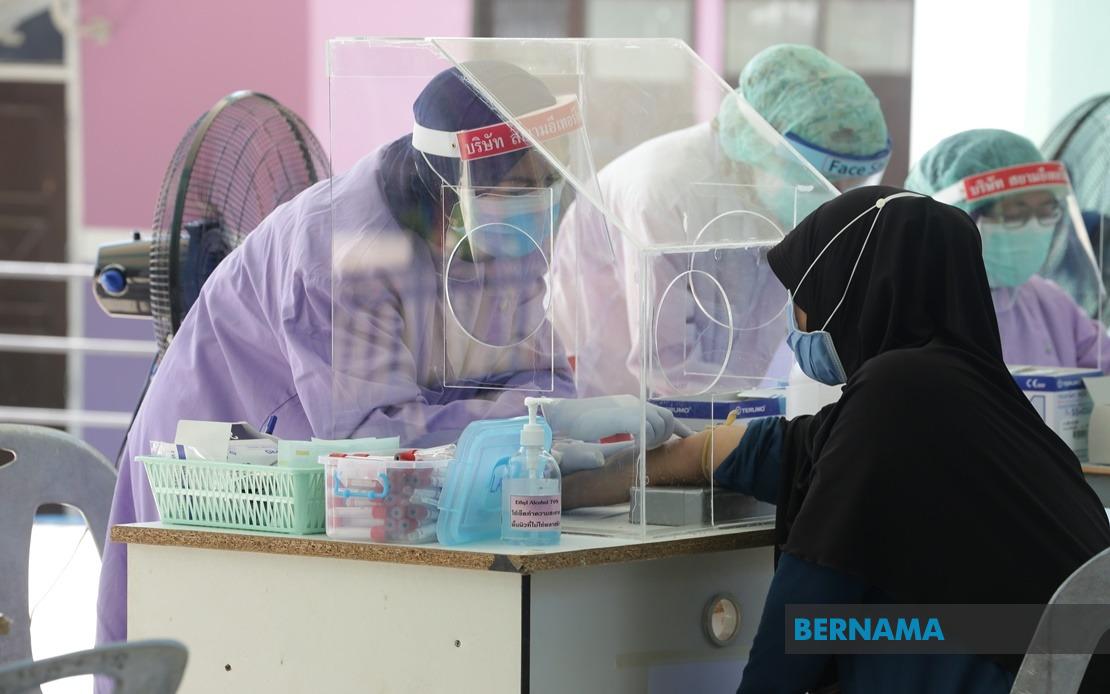COVID-19 Weekly Round-up: No Death Seven Days In A Row
By Melati Mohd Ariff
This is a round-up of COVID-19 related matters in Malaysia and globally from May 23 up to 7 pm today. In Malaysia, case numbers have exceeded 7,000 and globally, the virus has infected more than 5.9 million people and caused over 360,000 deaths. More than 200 countries and territories are affected by the pandemic.
KUALA LUMPUR (Bernama) – A new cluster involving the foreign workers of a cleaning company contributed to a spike in new COVID-19 cases today.
Over the last 24 hours up to noon today, 103 new cases were reported, bringing the total number of infections to 7,732 and active COVID-19 cases to 1,382.
Over the past seven days in a row, no fatality was reported and the death toll remained at 115 or 1.49 percent of Malaysia’s total cumulative COVID-19 cases.
Today’s 103 new cases consisted of seven imported cases and 96 local transmissions.
At his daily media conference today, Health director-general Datuk Dr Noor Hisham Abdullah said 84 of the local transmissions involved non-citizens, including 53 from the Pedas cluster and 24 from a new cleaning company cluster. Only 12 cases involved Malaysians.
Sixty-six patients were discharged today, taking the total recovered cases to 6,235, which translates into a recovery rate of 80.46 percent. Eight patients are being treated in intensive care units with two of them requiring ventilatory support.
Meanwhile, following the shocking three-digit spike in new COVID-19 cases on Monday and Tuesday, the number plunged to 10 yesterday – the lowest-ever figure recorded since the Movement Control Order (MCO) was enforced on March 18.
The 10 new cases comprised local transmissions with non-citizens accounting for five of them.
On Wednesday, 15 new COVID-19 cases (including six imported) were reported, out of which nine involved local transmissions – this was the first time since the MCO was enforced that local transmissions had dwindled to a single-digit figure with four of them involving non-citizens.
NEW WAVE WARNING
Health director-general Datuk Dr Noor Hisham Abdullah, during his daily media conference on Wednesday, reminded Malaysians that the war against COVID-19 has not ended yet and urged them not to throw caution to the wind.
He said the Ministry of Health (MOH) expects a new wave of cases if most people do not comply with the standard operating procedures (SOPs) set by the government.
SOP-compliance is absolutely crucial in view of the fact that a large number of COVID-19 positive cases are asymptomatic. This finding, shared by MOH on its official website, is based on COVID-19 screenings carried out on tahfiz school students and wet market workers.
During screenings carried out at 378 tahfiz schools and madrasah, 15,000 samples were collected and 684 positive cases were detected, out of which 588, or 86 percent, did not show any symptom of the disease.
As for screenings involving wet market workers, 271 were found positive but 234 of them or 86 percent did not show any symptom.
These results are worrying as asymptomatic COVID-19 positive people can unknowingly infect others.
Incidentally, Prime Minister Tan Sri Muhyiddin Yassin himself is now undergoing a 14-day quarantine because an officer who attended a post-Cabinet meeting at the Prime Minister’s Office last week had tested positive for COVID-19.
DEPOT CLUSTERS
The sharp spike in new cases on Monday (172 cases) and Tuesday (187) initially came as an unsettling shock but a breakdown of the statistics revealed that most of the new infections involved foreigners detained at three immigration detention depots.
Explaining the hike in new infections on MOH’s website on Wednesday, Dr Noor Hisham said the increase was due to case detection measures implemented at various Immigration Detention Depots (DTI). Other active clusters, also mainly involving non-citizens, had also contributed to the new cases reported.
“It is part of the government’s targeted approach to stem the transmission of COVID-19,” he said, referring transmissions.to the case detection measures.
Out of the 187 new cases reported on Tuesday, 10 were imported and the remaining 177, local
The locally-transmitted cases comprised 173 foreigners (including 155 detected at the Bukit Jalil DTI and 13 from the Cheras security guard cluster) and four Malaysians.
Out of the 172 new cases reported on Monday, five were imported and the remaining local transmissions. The 167 locally-transmitted cases consisted of 159 foreigners (including 112 detected at Sepang DTI, Bukit Jalil DTI and Semenyih DTI) and eight Malaysians.
The overall drop in local transmissions is due to the various public health measures implemented by the government under the MCO and conditional MCO. Public compliance with the new normal and business sectors’ adherence to the SOPs have also helped to keep new infections under control.
GLOBAL SCENARIO, STATISTICS
The World Health Organisation (WHO), meanwhile, has warned that nations that have recorded a reduction in COVID-19 cases may see a second peak of infections if they lift measures to halt the outbreak too soon.
WHO Health Emergencies Programme executive director Michael J. Ryan told a media briefing on Monday that the world is currently in the middle of the second wave of the pandemic.
“Epidemics often come in waves, which means that outbreaks could come back later this year (influenza season) in places where the first wave has subsided,” he warned.
According to CoronaTracker (which cites figures from various agencies such as WHO), the total number of COVID-19 cases worldwide now stood at 5,900,765 and deaths, 361,776. A total of 2,577,225 people have recovered from the disease.
The United States continues to top the list of countries with the highest number of infections at 1,768,346 cases and 103,330 deaths.
Brazil has overtaken Russia at the second spot with 438,812 cases and a death toll of 26,991. Russia comes next with 379,051 cases and 4,142 deaths, followed by Spain with 284,986 cases and 27,119 fatalities.
Eight other countries have also recorded cases exceeding the 100,000 mark: United Kingdom 269,127 cases (37,837 deaths), Italy 231,732 (33,142), France 186,238 (28,662), Germany 182,452 (8,570), India 165,386 (4,711), Turkey 160,979 (4,461), Iran 143,849 (7,627) and Peru 141,779 (4,099).
China, where the COVID-19 outbreak was first reported in December 2019, is now at the 14th place with 82,995 cases and 4,634 fatalities.
Another Latin American nation recording a substantial number of cases is Chile with 86,943 cases and 89 deaths.
In Southeast Asia, Singapore has the highest number at 33,249 cases and 23 deaths, followed by Indonesia 24,538 (1,496), Philippines 15,588 (921), Thailand 3,065 cases (57), Vietnam 327 (0), Myanmar 206 (six), Brunei 141 (two), Cambodia 124 (0) and Laos 19 (0).
Other nations with substantial COVID-19 cases include:
Canada 88,512 cases (6,877 deaths), Saudi Arabia 80,185 (441), Mexico 78,023 (8,597), Pakistan 61,227 (1,260), Belgium 57,849 (9,388), Qatar 50,914 (33), Holland 45,950 (5,903), Belarus 39,858 kes (219), Bangladesh 40,321 (559) and Equador 38,471 (3,313).
COVID-19 BACKGROUND
According to the WHO website, its China country office was informed of cases of pneumonia that were detected in Wuhan on Dec 31, 2019. On Jan 7, the Chinese authorities confirmed that the novel coronavirus can be transmitted from human to human.
Coronaviruses are a large family of viruses that cause illnesses ranging from the common cold to more severe diseases such as Severe Acute Respiratory Syndrome (SARS) and Middle East Respiratory Syndrome (MERS-COV).
A study of the virus’ genetic sequence suggested similarities to that seen in snakes and bats. China health officials identified the Huanan Seafood Market in Wuhan as the source of the transmission of the coronavirus.
On Feb 11, WHO announced the official name of the virus, COVID-19, which is an acronym for coronavirus 2019 – CO stands for corona, VI for virus and D for disease.
On Jan 30, WHO declared the coronavirus outbreak as a global emergency. By then, it had spread to 18 countries and caused 170 deaths. On March 11, COVID-19 was declared a pandemic by WHO.
WHO has described the COVID-19 outbreak as 10 times more dangerous than the A H1N1 Influenza, also known as Swine Flu.
Swine Flu, which occurred between January 2009 and August 2010, infected more than 1.6 million people and caused 18,449 fatalities.
The International Monetary Fund has warned that the global economic recession caused by the COVID-19 pandemic will be worse than the Great Depression of the 1930s.
Translated by Rema Nambiar
BERNAMA
HealthEdge
EXCLUSIVE

Pet Vaccination, Public Awareness And Surveillance Key Towards Rabies-free Southeast Asia - Experts
KUCHING, Dec 11 (Bernama) -- The goal of making Southeast Asia free from human rabies can be achieved through a total understanding of the disease, how it can be prevented and responsible pet ownership among communities, say experts.
read more ››IN FOCUS

TAVI KAEDAH BAIK PULIH INJAP JANTUNG TANPA PEMBEDAHAN




